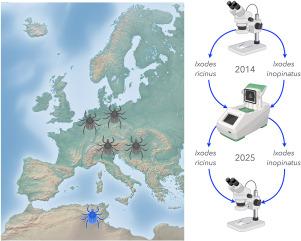What is the status of Ixodes inopinatus (Ixodidae)?
IF 1.7
Q3 PARASITOLOGY
Current research in parasitology & vector-borne diseases
Pub Date : 2025-01-01
DOI:10.1016/j.crpvbd.2025.100306
引用次数: 0
Abstract
The original description of Ixodes inopinatus is predominantly based on morphological and ecological characteristics. It was postulated that I. inopinatus is a cryptic species of the Ixodes ricinus complex, mainly found in the Mediterranean region of Spain, Portugal, Morocco, Algeria, and Tunisia. Although definitive proof is lacking, genetic insights support that I. inopinatus is a distinct species, but that the morphological characteristics, particularly from the adult stages, as well as molecular features, might not be distinctive enough for identification. In this study, we re-examined and expanded recently published results on the molecular relationships between I. ricinus and I. inopinatus, using the complete mitogenomes of 44 specimens of I. ricinus, 3 of Ixodes persulcatus, 3 of either Ixodes pomerantzevi, Ixodes scapularis, or Ixodes pacificus, and 6 of I. inopinatus from Northern Africa; the latter were identified as I. ricinus (in part) in previous reports. We managed to demonstrate that I. inopinatus has unique mitochondrial genomic features that allow the complete separation from I. ricinus collected in Europe. All specimens of I ricinus in Europe belong to four mitogenome clades that lack clear geographical structuring. Specimens found in Northern Africa belong to a fifth population. Although specimens of I. inopinatus have been reported in Central Europe, their link with such a fifth mitogenome has not yet been documented. To confirm the link between genetics and morphology, we recommend additional studies, ideally based on nymphs of I. ricinus and I. inopinatus, since they allow adequate morphological separation. Efforts should be directed to manage laboratory colonies to check for reproductive isolation, hybridization, and performance under different conditions of temperature and humidity.

伊蚊(伊蚊科)的现状如何?
对伊蠓的原始描述主要基于形态学和生态学特征。推测伊蚊是蓖麻伊蚊复合体的一个隐种,主要分布于西班牙、葡萄牙、摩洛哥、阿尔及利亚和突尼斯等地中海地区。虽然缺乏明确的证据,但遗传学的见解支持伊蠓是一个独特的物种,但形态学特征,特别是成虫阶段的形态学特征,以及分子特征,可能不够独特,无法进行鉴定。本研究利用44种蓖麻蜱、3种过弯伊蚊、3种pomerantzevi、3种scapularis、3种太平洋伊蚊和6种北非伊蚊的完整有丝分裂基因组,对最近发表的关于蓖麻蜱和伊蚊分子关系的研究成果进行了重新检验和扩展;后者在以前的报告中被确定为蓖麻虫(部分)。我们成功地证明了伊诺帕努斯鼠具有独特的线粒体基因组特征,使其与欧洲收集的蓖麻鼠完全分离。欧洲所有蓖麻属的标本都属于四个有丝分裂基因组分支,缺乏明确的地理结构。在北非发现的标本属于第五种。尽管在中欧已经报道了伊蚊的标本,但它们与第五个有丝分裂基因组的联系尚未得到记录。为了确认遗传和形态之间的联系,我们建议进行更多的研究,理想情况下是基于蓖麻螨和伊诺伊螨的若虫,因为它们允许足够的形态分离。应努力管理实验室菌落,检查在不同温度和湿度条件下的生殖分离、杂交和性能。
本文章由计算机程序翻译,如有差异,请以英文原文为准。
求助全文
约1分钟内获得全文
求助全文

 求助内容:
求助内容: 应助结果提醒方式:
应助结果提醒方式:


